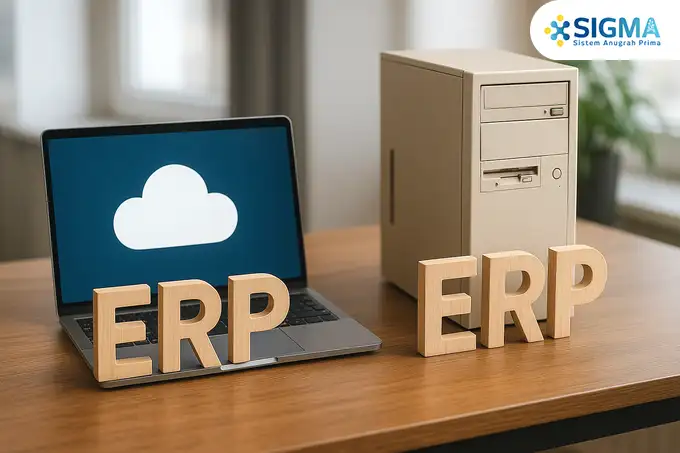Many business owners often find themselves at a crossroads when choosing between Cloud-based ERP software and On-Premise solutions. These two approaches carry distinct characteristics, advantages, and challenges.
On one hand, Cloud ERP is heralded as the future of digital transformation. On the other, On-Premise ERP remains a trusted option for large enterprises that demand complete control over their systems.
As a seasoned technology writer and practitioner—experienced in everything from network infrastructure to enterprise systems—I aim to unpack this topic with clarity, practicality, and real-world insights.
So you don’t simply follow trends, but truly understand which ERP system aligns best with your business needs.
What is ERP Software?
ERP (Enterprise Resource Planning) is an integrated system that enables companies to manage a range of core functions—from finance, inventory, and procurement to human resources—all within a unified platform.
Without ERP, data is often scattered across disparate systems, leading to sluggish decision-making and a higher risk of errors.
Cloud vs. On-Premise ERP: A Comparative Analysis
To fully grasp the differences between Cloud ERP and On-Premise ERP, let’s examine several critical aspects:
1. Installation & Hosting
- Cloud ERP: Hosted by the service provider, accessible via the internet.
- On-Premise ERP: Installed on the company’s internal servers, typically accessible only via local network or VPN.
2. Implementation Cost
- Cloud ERP: Lower upfront costs due to subscription-based pricing. No need to purchase servers or expensive licenses initially.
- On-Premise ERP: Higher initial investment—requires server purchase, software licensing, and IT setup. However, it may prove more economical in the long run for long-term use.
3. Maintenance & Updates
- Cloud ERP: Updates and maintenance are handled entirely by the provider. Users always access the latest version without hassle.
- On-Premise ERP: Requires an in-house IT team to manually manage system maintenance and updates.
4. Mobility & Accessibility
- Cloud ERP: Accessible from anywhere with internet connectivity. Ideal for remote teams and field sales operations.
- On-Premise ERP: Access is limited unless augmented with remote/VPN setups. Less suited to high-mobility environments.
5. Control & Customization
- Cloud ERP: Customization options are generally constrained by vendor-defined parameters. Suitable for standard business needs.
- On-Premise ERP: Highly customizable. Can be tailored extensively to fit internal SOPs and workflows.
6. Security & Data Ownership
- Cloud ERP: Data resides on vendor servers, usually protected by robust security certifications (e.g., ISO 27001).
- On-Premise ERP: Data remains under the company’s full control—ideal for sectors with stringent compliance such as finance or pharmaceuticals.
7. Downtime & Internet Dependency
- Cloud ERP: Heavily reliant on stable internet connectivity and the provider’s server uptime.
- On-Premise ERP: As long as the internal network is stable, the system is less vulnerable to external connectivity disruptions.
Why Consider Cloud ERP?
Many SMEs and startups are leaning toward Cloud ERP for several compelling reasons:
1. Low Initial Investment
No need for expensive servers, licenses, or IT staffing. Perfect for businesses in early stages or those with limited cash flow.
2. Effortless Scalability
Add users or modules with a few clicks. Ideal for rapidly growing enterprises.
3. Automatic Updates
No need to worry about patches or bug fixes—everything is managed by the provider.
4. High Mobility
Your team can work from the office, from home, or even on the move.
5. Advanced Security
Top-tier providers comply with global standards such as ISO/IEC 27001 and deploy sophisticated data encryption.
Strengths of On-Premise ERP
Though more complex, On-Premise ERP is far from obsolete.
1. Complete Data Control
All data is stored internally. This is ideal for industries with rigorous regulatory demands (e.g., banking, pharmaceuticals).
2. Extensive Customization
Tailor the ERP system precisely to your business processes without vendor-imposed limits.
3. Easier Local Integration
Need to connect with legacy accounting systems, factory machinery, or RFID tech? On-Premise systems are typically more adaptable.
When Should You Choose Cloud ERP?
Opt for Cloud ERP if:
- You’re a startup, SME, or operate a distributed team.
- You seek fast deployment and cost efficiency.
- You lack a strong internal IT department.
- You prefer focusing on core operations over server management.
Example:
A national snack distribution company uses Cloud ERP for managing orders, inventory, and sales. Their sales team can update data via smartphones during store visits—enabling real-time operations without waiting for weekly reports.
When Should You Choose On-Premise ERP?
Go for On-Premise ERP if:
- You have strict data privacy or regulatory compliance requirements.
- You need a highly customized system aligned with your internal SOPs.
- You already have a solid IT infrastructure and skilled internal team.
Example:
An automotive manufacturer needs tight integration with production lines and warehouse automation. They opt for On-Premise ERP to ensure full control and maximum data security.
Tips for Choosing Between Cloud and On-Premise ERP
Here are some practical guidelines before making your ERP decision:
- Evaluate your business processes. Do you need high mobility or deep customization?
- Review your budget and ROI. Factor in both initial and long-term costs.
- Understand your industry’s compliance needs. Regulated sectors like healthcare and finance require extra diligence.
- Assess the vendor. Request demos, review their SLA, and check support availability.
- Engage your internal team. Involve finance, IT, and operations in the decision-making process.
Conclusion
Cloud vs. On-Premise ERP is not a battle of which is inherently better—but rather a matter of what best suits your business needs.
If you:
- Value convenience, speed, and efficiency → Cloud ERP is the answer.
- Require full control, local data, and deep integration → On-Premise ERP is more suitable.
What truly matters is not following trends blindly. Understand your requirements, evaluate your internal capacity, and ensure your ERP vendor has both a strong track record and reliable support.


